Identification of New Fusarium sulawense Strains Causing Soybean Pod Blight in China and Their Control Using Carbendazim, Dipicolinic Acid and Kojic Acid
Abstract
:1. Introduction
2. Materials and Methods
2.1. Sample Collection and Fungal Isolation
2.2. Morphological Characterization
2.3. Sequence Analysis
2.4. Construction of the Phylogenetic Tree
2.5. Pathogenicity Test
2.6. PCR Assay of Trichothecene Biosynthetic Genes
2.7. Efficacy of Carbendazim, Dipicolinic Acid and Kojic Acid for the Control of F. sulawense on Soybean Pods
2.8. Combinations of Carbendazim, Dipicolinic Acid and Kojic Acid for the Control of F. sulawense on Soybean Pods
2.9. Combinations of Carbendazim, Dipicolinic Acid and Kojic Acid for the Control of F. sulawense on Soybean Pods
2.10. Statistical Analysis
3. Results
3.1. F. sulawense Was Identified as the Causal Agent of Soybean Pod Blight in Nantong Municipality
3.2. Combinations of Carbendazim, Dipicolinic Acid and Kojic Acid Reduced the Symptoms of F. sulawense on Soybean Pods
4. Discussion
5. Conclusions
Supplementary Materials
Author Contributions
Funding
Institutional Review Board Statement
Informed Consent Statement
Data Availability Statement
Conflicts of Interest
References
- Food and Agriculture Organization of the United Nations (FAO). 2020. Available online: http://www.fao.org/faostat/en/#data/QCL/visualize (accessed on 1 May 2022).
- Wang, S.Y.; Zhang, Y.J.; Zhu, G.Y.; Shi, X.C.; Chen, X.; Herrera-Balandrano, D.D.; Liu, F.Q.; Laborda, P. Occurrence of isoflavones in soybean sprouts and strategies to enhance their content: A review. J. Food Sci. 2022, 87, 1961–1982. [Google Scholar] [CrossRef]
- Jayachandran, M.; Xu, B.J. An insight into the health benefits of fermented soy products. Food Chem. 2019, 271, 362–371. [Google Scholar] [CrossRef] [PubMed]
- Bandara, A.Y.; Weerasooriya, D.K.; Bradley, C.A.; Allen, T.W.; Esker, P.D. Dissecting the economic impact of soybean diseases in the United States over two decades. PLoS ONE 2020, 15, e0231141. [Google Scholar] [CrossRef] [Green Version]
- Liu, S.M.; Kandoth, P.K.; Warren, S.D.; Yeckel, G.; Heinz, R.; Alden, J.; Yang, C.L.; Jamai, A.; El-Mellouki, T.; Juvale, P.S.; et al. A soybean cyst nematode resistance gene points to a new mechanism of plant resistance to pathogens. Nature 2012, 492, 256. [Google Scholar] [CrossRef]
- Ma, Z.C.; Zhu, L.; Song, T.Q.; Wang, Y.; Zhang, Q.; Xia, Y.Q.; Qiu, M.; Lin, Y.C.; Li, H.Y.; Kong, L.; et al. A paralogous decoy protects Phytophthora sojae apoplastic effector PsXEG1 from a host inhibitor. Science 2017, 355, 710–714. [Google Scholar] [CrossRef] [PubMed]
- Peltier, A.J.; Bradley, C.A.; Chilvers, M.I.; Malvick, D.K.; Mueller, D.S.; Wise, K.A.; Esker, P.D. Biology, yield loss and control of Sclerotinia stem rot of soybean. J. Integr. Pest Manag. 2012, 3, B1–B7. [Google Scholar] [CrossRef] [Green Version]
- Savary, S.; Willocquet, L.; Pethybridge, S.J.; Esker, P. The global burden of pathogens and pests on major food crops. Nat. Ecol. Evol. 2019, 3, 430. [Google Scholar] [CrossRef] [PubMed]
- Hui, Y.; Nelson, B. Effects of soil type, temperature and moisture on development of Fusarium root rot of soybean by Fusarium solani (FSSC 11) and Fusarium tricinctum. Plant Dis. 2022. [Google Scholar] [CrossRef]
- Liu, B.; Wei, H.H.; Shen, W.S.; Smith, H. Long-term effect of non-irrigation and irrigation on soil Pythium, Fusarium, and Rhizoctonia communities and their relation with seed-rot, root-rot, and damping-off of soybean. Eur. J. Plant Pathol. 2020, 158, 297–314. [Google Scholar] [CrossRef]
- Zheng, N.; Zhang, L.P.; Ge, F.Y.; Huang, W.K.; Kong, L.A.; Peng, D.L.; Liu, S.M. Conidia of one Fusarium solani isolate from a soybean-production field enable to be virulent to soybean and make soybean seedlings wilted. J. Integr. Agric. 2018, 17, 2042–2053. [Google Scholar] [CrossRef]
- Chiotta, M.L.; Zanon, M.S.A.; Palazzini, J.M.; Scandiani, M.M.; Formento, A.N.; Barros, G.G.; Chulze, S.N. Pathogenicity of Fusarium graminearum and F. meridionale on soybean pod blight and trichothecene accumulation. Plant Pathol. 2016, 65, 1492–1497. [Google Scholar] [CrossRef] [Green Version]
- Li, Y.G.; Jiang, W.Y.; Li, S.; Jiang, D.; Wang, R.T.; Ji, P.; Pan, H.Y. Occurrence of cotyledon spot on soybean caused by Fusarium oxysporum in China. Plant Dis. 2019, 103, 2967. [Google Scholar] [CrossRef]
- Cruz, D.R.; Leandro, L.F.S.; Munkvold, G.P. Effects of temperature and pH on Fusarium oxysporum and soybean seedling disease. Plant Dis. 2019, 103, 3234–3243. [Google Scholar] [CrossRef]
- Chang, K.F.; Hwang, S.F.; Conner, R.L.; Ahmed, H.U.; Zhou, Q.; Turnbull, G.D.; Strelkov, S.E.; McLaren, D.L.; Gossen, B.D. First report of Fusarium proliferatum causing root rot in soybean (Glycine max L.) in Canada. Crop Prot. 2015, 67, 52–58. [Google Scholar] [CrossRef]
- Chang, X.L.; Li, H.J.; Naeem, M.; Wu, X.L.; Yong, T.W.; Song, C.; Liu, T.G.; Chen, W.Q.; Yang, W.Y. Diversity of the seedborne fungi and pathogenicity of Fusarium species associated with intercropped soybean. Pathogens 2020, 9, 531. [Google Scholar] [CrossRef] [PubMed]
- Chang, X.L.; Dai, H.; Wang, D.P.; Zhou, H.H.; He, W.Q.; Fu, Y.; Ibrahim, F.; Zhou, Y.; Gong, G.S.; Shang, J.; et al. Identification of Fusarium species associated with soybean root rot in Sichuan Province, China. Eur. J. Plant Pathol. 2018, 151, 563–577. [Google Scholar] [CrossRef]
- Pimentel, M.F.; Arnao, E.; Warner, A.J.; Subedi, A.; Rocha, L.F.; Srour, A.; Bond, J.; Fakhoury, A.M. Trichoderma isolates inhibit Fusarium virguliforme growth, reduce root rot, and induce defense-related genes on soybean seedlings. Plant Dis. 2020, 104, 1949–1959. [Google Scholar] [CrossRef] [PubMed]
- Zhou, Q.X.; Li, N.N.; Chang, K.F.; Hwang, S.F.; Strelkov, S.E.; Conner, R.L.; McLaren, D.L.; Fu, H.T.; Harding, M.W.; Turnbull, G.D. Genetic diversity and aggressiveness of Fusarium species isolated from soybean in Alberta, Canada. Crop Prot. 2018, 105, 49–58. [Google Scholar] [CrossRef]
- Zelechowski, M.; Molcan, T.; Bilska, K.; Myszczynski, K.; Olszewski, J.; Karpiesiuk, K.; Wyrebek, J.; Kulik, T. Patterns of diversity of Fusarium fungi contaminating soybean grains. Toxins 2022, 13, 884. [Google Scholar] [CrossRef]
- Zhao, L.; Wei, X.; Zheng, T.; Gou, Y.N.; Wang, J.; Deng, J.X.; Li, M.J. Evaluation of pathogenic Fusarium spp. associated with soybean seed (Glycine max L.) in Hubei Province, China. Plant Dis. 2022, in press. [Google Scholar] [CrossRef]
- Lu, Y.A.; Qiu, J.B.; Wang, S.F.; Xu, J.H.; Ma, G.Z.; Shi, J.R.; Bao, Z.H. Species diversity and toxigenic potential of Fusarium incarnatum-equiseti species complex isolates from rice and soybean in China. Plant Dis. 2021, 105, 2628–2636. [Google Scholar] [CrossRef] [PubMed]
- Pierzgalski, A.; Bryla, M.; Kanabus, J.; Modrzewska, M.; Podolska, G. Updated review of the toxicity of selected Fusarium toxins and their modified forms. Toxins 2021, 13, 768. [Google Scholar] [CrossRef] [PubMed]
- Kamle, M.; Mahato, D.K.; Devi, S.; Lee, K.E.; Kang, S.G.; Kumar, P. Fumonisins: Impact on agriculture, food, and human health and their management strategies. Toxins 2019, 11, 328. [Google Scholar] [CrossRef] [PubMed] [Green Version]
- Montoya-Martinez, A.C.; O’Donnell, K.; Busman, M.; Vaughan, M.M.; McCormick, S.P.; Santillan-Mendoza, R.; Pineda-Vaca, D.; Clapes-Garduno, L.; Fernandez-Pavia, S.P.; Ploetz, R.C.; et al. Weeds harbor Fusarium species that cause malformation disease of economically important trees in Western Mexico. Plant Dis. 2022, 106, 612–622. [Google Scholar] [CrossRef] [PubMed]
- Zhang, K.; Su, Y.Y.; Cai, L. An optimized protocol of single spore isolation for fungi. Cryptogam. Mycol. 2013, 34, 349–356. [Google Scholar] [CrossRef]
- Leyva-Mir, S.G.; Garcia-Leon, E.; Camacho-Tapia, M.; Villasenor-Mir, H.E.; Leyva-Madrigal, K.Y.; Mora-Romero, G.A.; Tovar-Pedraza, J.M. Occurrence of the Fusarium incarnatum-equiseti species complex causing Fusarium head blight of wheat in Mexico. Plant Dis. 2022, in press. [Google Scholar] [CrossRef]
- Sunpapao, A.; Suwannarach, N.; Kumla, J.; Dumhai, R.; Riangwong, K.; Sanguansub, S.; Wanchana, S.; Arikit, S. Morphological and molecular identification of plant pathogenic fungi associated with dirty panicle disease in coconuts (Cocos nucifera) in Thailand. J. Fungi 2022, 8, 335. [Google Scholar] [CrossRef]
- Xie, Y.; Sun, Q.; Zhang, S.; Shi, X.; Herrera-Balandrano, D.D.; Wang, S.; Laborda, P. First report of Fusarium acuminatum causing leaf blight on garlic in China. Plant Dis. 2022, in press. [Google Scholar] [CrossRef]
- Maryani, N.; Sandoval-Denis, M.; Lombard, L.; Crous, P.W.; Kema, G.H.J. New endemic Fusarium species hitch-hiking with pathogenic Fusarium strains causing Panama disease in small-holder banana plots in Indonesia. Persoonia 2019, 43, 48–69. [Google Scholar] [CrossRef] [Green Version]
- Xiao, X.E.; Wang, W.; Crous, P.W.; Wang, H.K.; Jiao, C.; Huang, F.; Pu, Z.X.; Zhu, Z.R.; Li, H.Y. Species of Botryosphaeriaceae associated with citrus branch diseases in China. Persoonia 2021, 47, 106–135. [Google Scholar] [CrossRef]
- Stepien, L.; Gromadzka, K.; Chelkowski, J. Polymorphism of mycotoxin biosynthetic genes among Fusarium equiseti isolates from Italy and Poland. J. Appl. Genet. 2012, 53, 227–236. [Google Scholar] [CrossRef] [PubMed] [Green Version]
- Nicholson, P.; Simpson, D.R.; Wilson, A.H.; Chandler, E.; Thomsett, M. Detection and differentiation of trichothecene and enniatin-producing Fusarium species on small-grain cereals. Eur. J. Plant Pathol. 2004, 110, 503–514. [Google Scholar] [CrossRef]
- Tonu Agrotech Ltd. 2022. Available online: http://www.tonuagrotech.com/products_info/Carbendazim-50--SC-363774.html (accessed on 1 May 2022).
- Song, X.G.; Han, M.H.; He, F.; Wang, S.Y.; Li, C.H.; Wu, G.C.; Huang, Z.G.; Liu, D.; Liu, F.Q.; Laborda, P.; et al. Antifungal mechanism of dipicolinic acid and its efficacy for the biocontrol of pear Valsa canker. Front. Microbiol. 2020, 11, 958. [Google Scholar] [CrossRef] [PubMed]
- Zhu, G.Y.; Shi, X.C.; Wang, S.Y.; Wang, B.; Laborda, P. Antifungal mechanism and efficacy of kojic acid for the control of Sclerotinia sclerotiorum in soybean. Front. Plant Sci. 2022, 13, 845698. [Google Scholar] [CrossRef]
- Wang, M.M.; Chen, Q.; Diao, Y.Z.; Duan, W.J.; Cai, L. Fusarium incarnatum-equiseti complex from China. Persoonia 2019, 43, 70–89. [Google Scholar] [CrossRef] [Green Version]
- Xia, J.W.; Sandoval-Denis, M.; Crous, P.W.; Zhang, X.G.; Lombard, L. Numbers to names—Restyling the Fusarium incarnatum-equiseti species complex. Persoonia 2019, 43, 186–221. [Google Scholar] [CrossRef]
- Jedidi, I.; Jurado, M.; Cruz, A.; Trabelsi, M.M.; Said, S.; Gonzalez-Jaen, M.T. Phylogenetic analysis and growth profiles of Fusarium incarnatum-equiseti species complex strains isolated from Tunisian cereals. Int. J. Food Microbiol. 2021, 353, 109297. [Google Scholar] [CrossRef]
- Lima, E.N.; Oster, A.H.; Bordallo, P.N.; Araujo, A.A.C.; Silva, D.E.M.; Lima, C.S. A novel lineage in the Fusarium incarnatum-equisetis pecies complex is one of the causal agents of fusarium rot on melon fruits in Northeast Brazil. Plant Pathol. 2021, 70, 133–143. [Google Scholar] [CrossRef]
- Yi, R.H.; Lian, T.; Su, J.J.; Chen, J. First report of internal black rot on Carica papaya fruit caused by Fusarium sulawesiense in China. Plant Dis. 2022, 106, 319. [Google Scholar] [CrossRef]
- Lu, M.; Zhang, Y.; Li, Q.; Huang, S.; Tang, L.; Chen, X.; Guo, T.; Mo, J.; Ma, L. First report of leaf blight caused by Fusarium pernambucanum and Fusarium sulawesiense on plum in Sichuan, China. Plant Dis. 2022, in press. [Google Scholar] [CrossRef]
- Guo, Z.N.; Yu, Z.H.; Li, Q.L.; Tang, L.H.; Guo, T.X.; Huang, S.P.; Mo, J.Y.; Hsiang, T.; Luo, S.M. Fusarium species associated with leaf spots of mango in China. Microb. Pathog. 2021, 150, 104736. [Google Scholar] [CrossRef] [PubMed]
- Kamran, M.; Ullah, I.; Ul Haq, M.E.; Iqba, M.; Abbas, H.; Nazir, S.; Ali, S.; Khan, Q.A.T.; Idrees, M. First report of Fusarium sulawesiensis (FIESC-16) associated with stem rot of sesame in Pakistan. Plant Dis. 2020, 104, 1554. [Google Scholar] [CrossRef]
- Pramunadipta, S.; Widiastuti, A.; Wibowo, A.; Suga, H.; Priyatmojo, A. Identification and pathogenicity of Fusarium spp. associated with the sheath rot disease of rice (Oryza sativa) in Indonesia. J. Plant Pathol. 2022, 104, 251–267. [Google Scholar] [CrossRef]
- Xue, A.G.; Cober, E.; Voldeng, H.D.; Babcock, C.; Clear, R.M. Evaluation of the pathogenicity of Fusarium graminearum and Fusarium pseudograminearum on soybean seedlings under controlled conditions. Can. J. Plant Pathol. 2007, 29, 35–40. [Google Scholar] [CrossRef]
- Abdelmagid, A.; Hafez, M.; Lawley, Y.; Rehal, P.K.; Daayf, F. First report of pod and stem blight and seed decay caused by Diaporthe longicolla on soybean in Western Canada. Plant Dis. 2022, 106, 1061. [Google Scholar] [CrossRef]
- Udayanga, D.; Castlebury, L.A.; Rossman, A.Y.; Chukeatirote, E.; Hyde, K.D. The Diaporthe sojae species complex: Phylogenetic re-assessment of pathogens associated with soybean, cucurbits and other field crops. Fungal Biol. 2015, 119, 383–407. [Google Scholar] [CrossRef]
- Brumer, B.B.; Lopes-Caitar, V.S.; Chicowski, A.S.; Beloti, J.D.; Castanho, F.M.; da Silva, D.C.G.; de Carvalho, S.; Lopes, I.O.N.; Soares, R.M.; Seixas, C.D.S.; et al. Morphological and molecular characterization of Diaporthe (anamorph Phomopsis) complex and pathogenicity of Diaporthe aspalathi isolates causing stem canker in soybean. Eur. J. Plant Pathol. 2018, 151, 1009–1025. [Google Scholar] [CrossRef]
- Sun, Q.; Xie, Y.J.; Chen, T.M.; Zhang, J.P.; Laborda, P.; Wang, S.Y. First report of Fusarium avenaceum causing canker disease on kiwi tree in China. Plant Dis. 2022, 106, 1762. [Google Scholar] [CrossRef]
- Crous, P.W.; Lombard, L.; Sandoval-Denis, M.; Seifert, K.A.; Schroers, H.J.; Chaverri, P.; Gene, J.; Guarro, J.; Hirooka, Y.; Bensch, K.; et al. Fusarium: More than a node or a foot-shaped basal cell. Stud. Mycol. 2021, 98, 100116. [Google Scholar] [CrossRef]
- Piacentini, K.C.; Rocha, L.O.; Savi, G.D.; Carnielli-Queiroz, L.; Fontes, L.D.; Correa, B. Assessment of toxigenic Fusarium species and their mycotoxins in brewing barley grains. Toxins 2019, 11, 31. [Google Scholar] [CrossRef] [Green Version]
- Yin, Q.; Shi, X.; Zhu, Z.; Tian, L.; Wang, Y.; Zhao, X.; Jia, Z.; Ma, L. First report of Fusarium solani (FSSC 6) associated with the root rot of Magnolia denudata in China. Plant Dis. 2022, in press. [Google Scholar] [CrossRef] [PubMed]
- Tralamazza, S.M.; Piacentini, K.C.; Savi, G.D.; Carnielli-Queiroz, L.; Fontes, L.D.; Martins, C.S.; Correa, B.; Rocha, L.O. Wild rice (O. latifolia) from natural ecosystems in the Pantanal region of Brazil: Host to Fusarium incarnatum-equiseti species complex and highly contaminated by zearalenone. Int. J. Food Microbiol. 2021, 345, 109127. [Google Scholar] [CrossRef] [PubMed]
- Mishra, S.; Srivastava, S.; Dewangan, J.; Divakar, A.; Rath, S.K. Global occurrence of deoxynivalenol in food commodities and exposure risk assessment in humans in the last decade: A survey. Crit. Rev. Food Sci. Nutr. 2020, 60, 1346–1374. [Google Scholar] [CrossRef] [PubMed]
- Foroud, N.A.; Baines, D.; Gagkaeva, T.Y.; Thakor, N.; Badea, A.; Steiner, B.; Burstmayr, M.; Burstmayr, H. Trichothecenes in cereal grains—An update. Toxins 2019, 11, 634. [Google Scholar] [CrossRef] [PubMed] [Green Version]
- You, L.; Zhao, Y.Y.; Kuca, K.; Wang, X.; Oleksak, P.; Chrienova, Z.; Nepovimova, E.; Jacevic, V.; Wu, Q.H.; Wu, W.D. Hypoxia, oxidative stress, and immune evasion: A trinity of the trichothecenes T-2 toxin and deoxynivalenol (DON). Arch. Toxicol. 2021, 95, 1899–1915. [Google Scholar] [CrossRef]
- Maresca, M. From the gut to the brain: Journey and pathophysiological effects of the food-associated trichothecene mycotoxin deoxynivalenol. Toxins 2013, 5, 784–820. [Google Scholar] [CrossRef]
- Rama, E.M.; Bortolan, S.; Vieira, M.L.; Ceccatto Gerardin, D.C.; Moreira, E.G. Reproductive and possible hormonal effects of carbendazim. Regul. Toxicol. Pharmacol. 2014, 69, 476–486. [Google Scholar] [CrossRef]
- Molin, C.; Ribeiro, N.R.; Matusomoto, M.N.; Lutkemeyer, A.J.; Bordignon, K.B.; Ferreira, M.L.B.; Barbieri, M.; Deuner, C.C.; Huzar-Novakowiski, J. Seed treatment for controlling damping-off caused by Globisporangium irregulare and Globisporangium ultimum var. sporangiiferum in soybean from southern Brazil. Crop Prot. 2021, 149, 105782. [Google Scholar]
- Wang, S.Y.; Shi, X.C.; Liu, F.Q.; Laborda, P. Chromatographic methods for detection and quantification of carbendazim in food. J. Agric. Food Chem. 2020, 68, 11880–11894. [Google Scholar] [CrossRef]
- Singh, S.; Singh, N.; Kumar, V.; Datta, S.; Wani, A.B.; Singh, D.; Singh, K.; Singh, J. Toxicity, monitoring and biodegradation of the fungicide carbendazim. Environ. Chem. Lett. 2016, 14, 317–329. [Google Scholar] [CrossRef]
- Lopez-Pacheco, I.Y.; Silva-Nunez, A.; Salinas-Salazar, C.; Arevalo-Gallegos, A.; Lizarazo-Holguin, L.A.; Barcelo, D.; Iqbal, H.M.N.; Parra-Saldivar, R. Anthropogenic contaminants of high concern: Existence in water resources and their adverse effects. Sci. Total Environ. 2019, 690, 1068–1088. [Google Scholar] [CrossRef] [PubMed]
- Zhu, G.Y.; Chen, Y.; Wang, S.Y.; Shi, X.C.; Herrera-Balandrano, D.D.; Polo, V.; Laborda, P. Peel diffusion and antifungal efficacy of different fungicides in pear fruit: Structure-diffusion-activity relationships. J. Fungi 2022, 8, 547. [Google Scholar] [CrossRef] [PubMed]
- Wang, T.; Wang, X.C.; Han, M.H.; Song, X.G.; Yang, D.J.; Wang, S.Y.; Laborda, P.; Shi, X.C. Enhanced spoVF operon increases host attachment and biocontrol ability of Bacillus subtilis for the management of Ceratocystis fimbriata in sweet potato. Biol. Control 2021, 161, 104651. [Google Scholar] [CrossRef]
- Saeedi, M.; Eslamifar, M.; Khezri, K. Kojic acid applications in cosmetic and pharmaceutical preparations. Biomed. Pharmacother. 2019, 110, 582–593. [Google Scholar] [CrossRef]
- Santoso, P.; Minamihata, K.; Ishimine, Y.; Taniguchi, H.; Komada, T.; Sato, R.; Goto, M.; Takashima, T.; Taira, T.; Kamiya, N. Enhancement of the antifungal activity of chitinase by palmitoylation and the synergy of palmitoylated chitinase with amphotericin B. ACS Infect. Dis. 2022, 8, 1051–1061. [Google Scholar] [CrossRef]
- Boufleur, T.R.; Ciampi-Guillardi, M.; Tikami, I.; Rogerio, F.; Thon, M.R.; Sukno, S.A.; Massola, N.S.; Baroncelli, R. Soybean anthracnose caused by Colletotrichum species: Current status and future prospects. Mol. Plant Pathol. 2021, 22, 393–409. [Google Scholar] [CrossRef]
- Molina, J.P.E.; Navarro, B.L.; Allen, T.W.; Godoy, C.V. Soybean target spot caused by Corynespora cassiicola: A resurgent disease in the Americas. Trop. Plant Pathol. 2022, 47, 315–331. [Google Scholar] [CrossRef]
- Ellis, M.L.; Broders, K.D.; Paul, P.A.; Dorrance, A.E. Infection of soybean seed by Fusarium graminearum and effect of seed treatments on disease under controlled conditions. Plant Dis. 2011, 95, 401–407. [Google Scholar] [CrossRef] [Green Version]
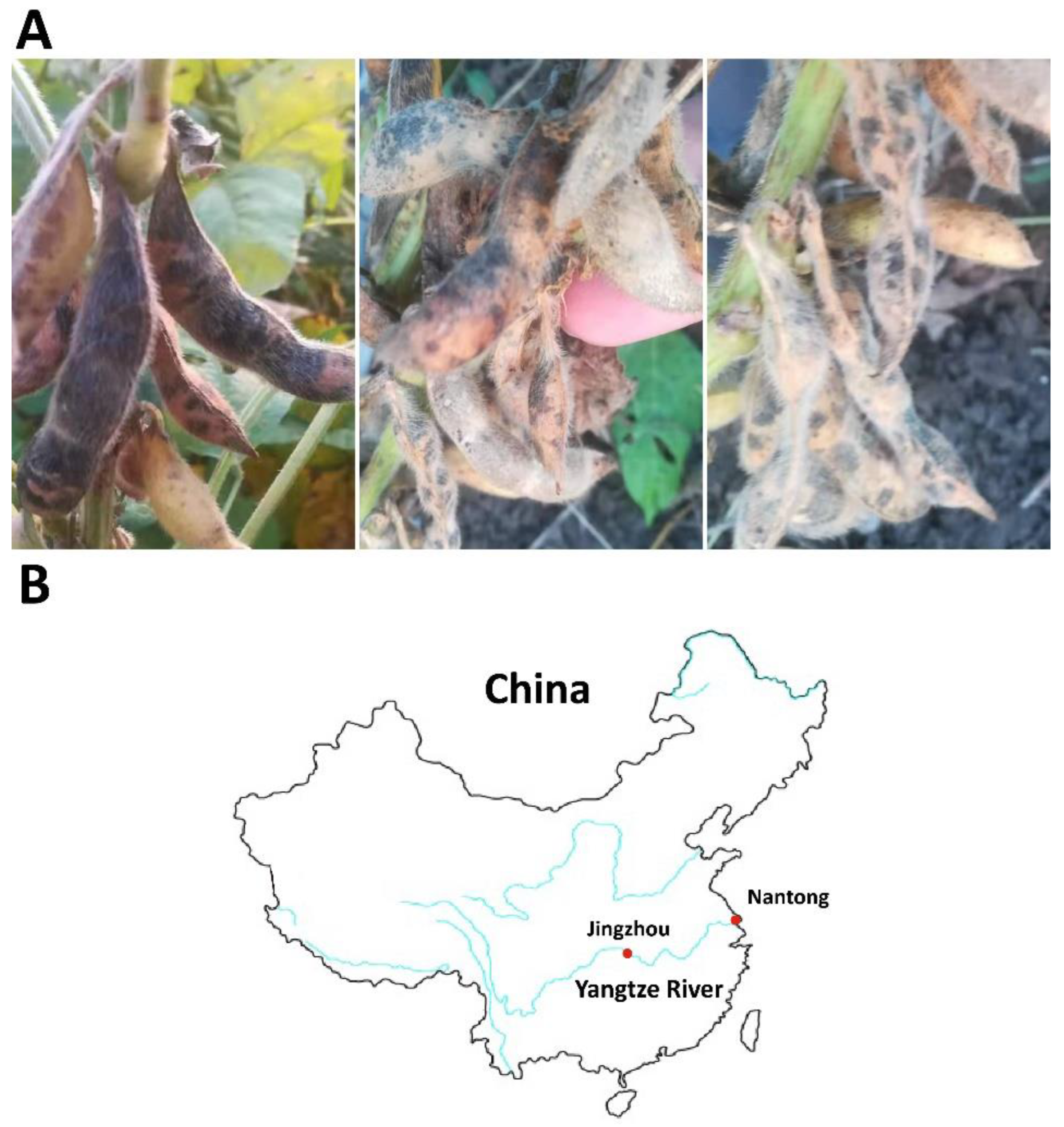
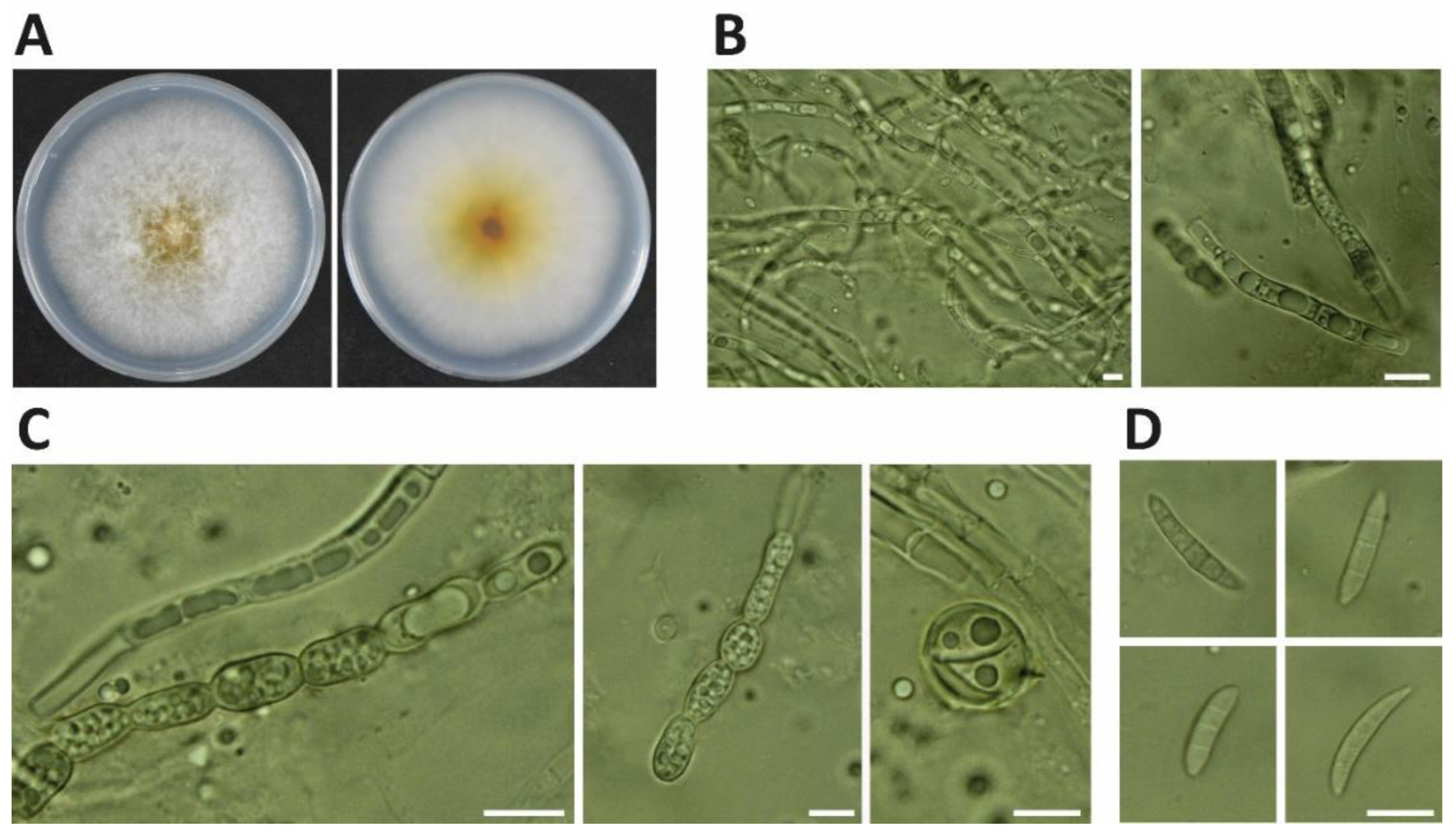
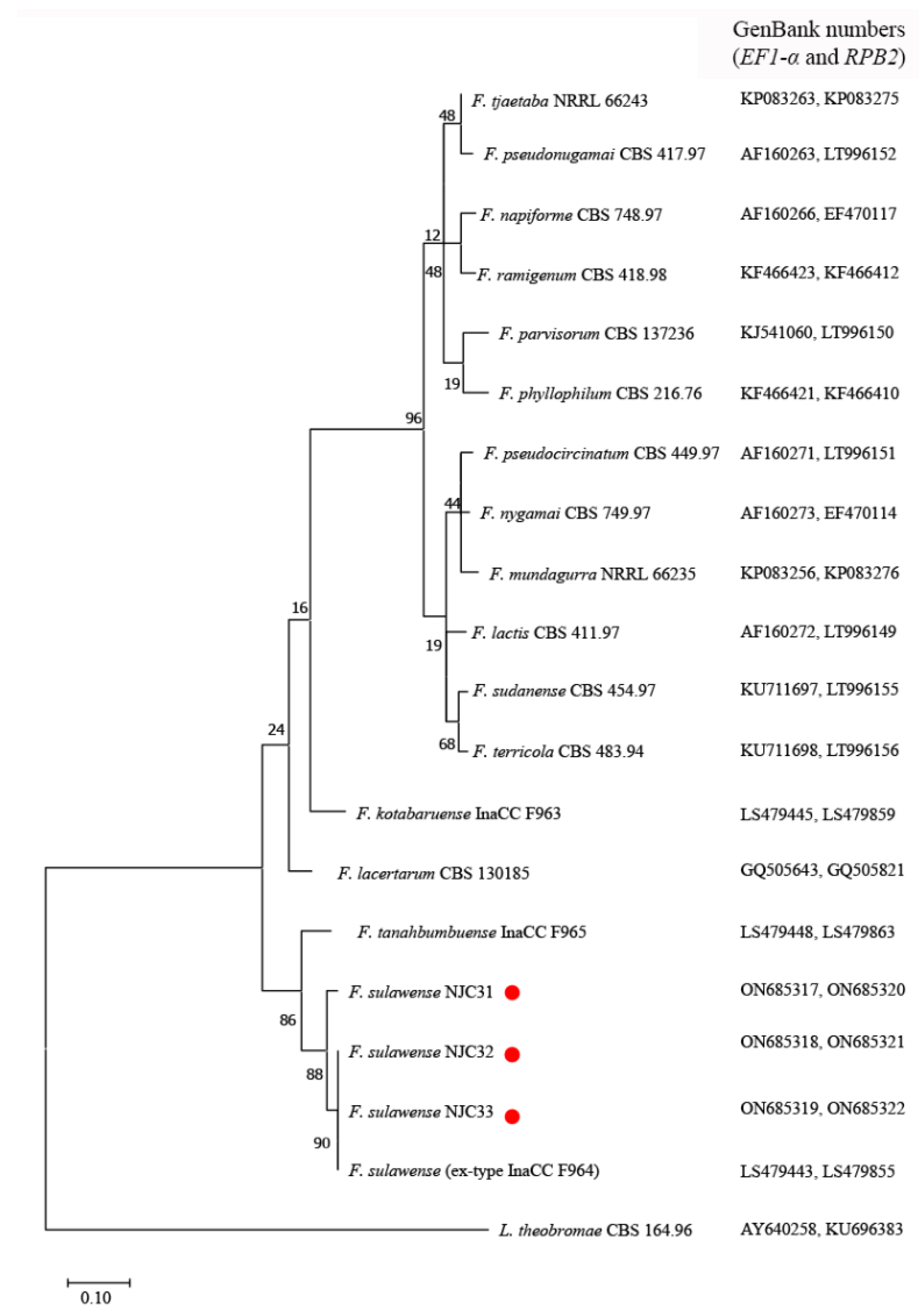
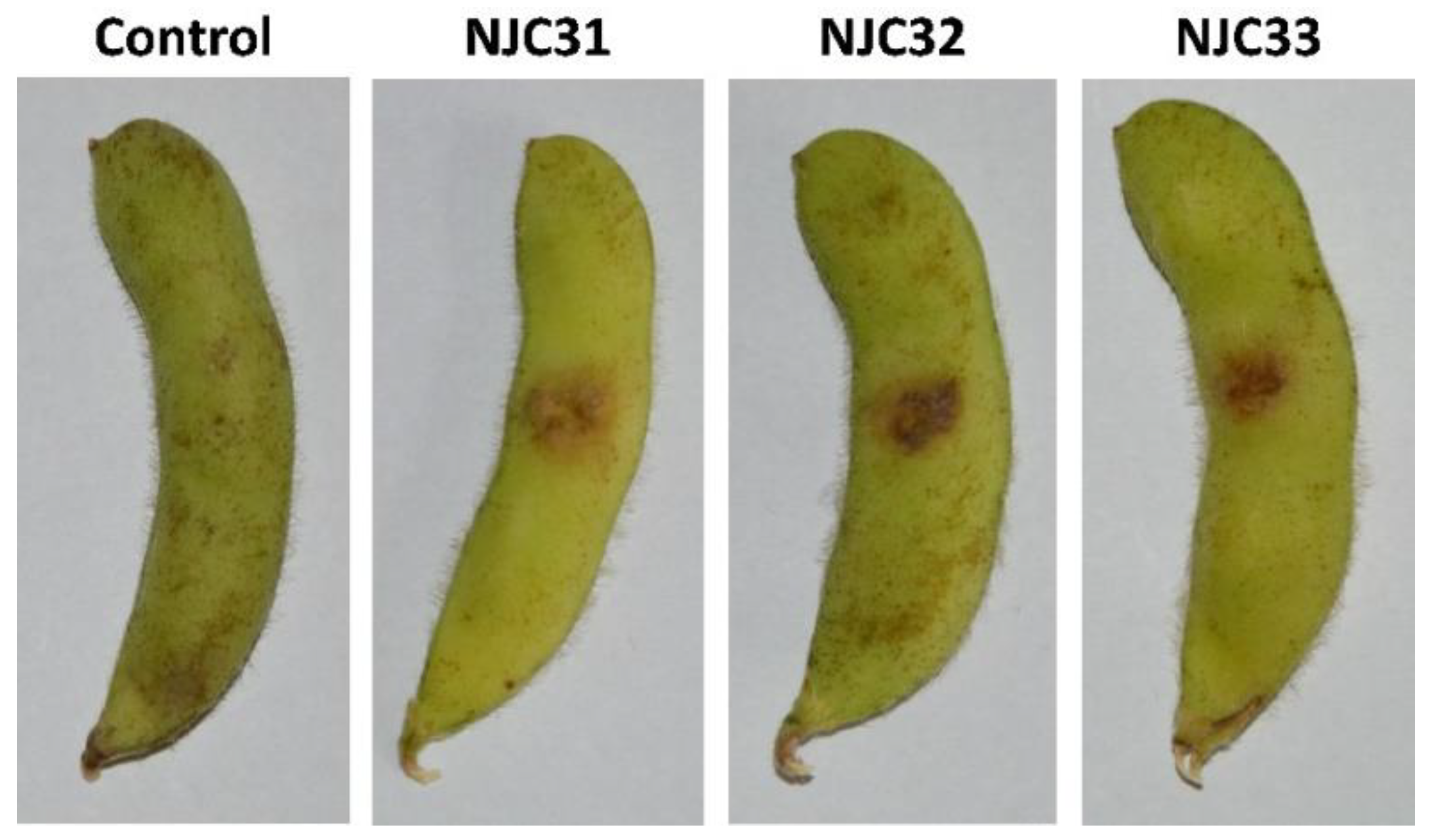
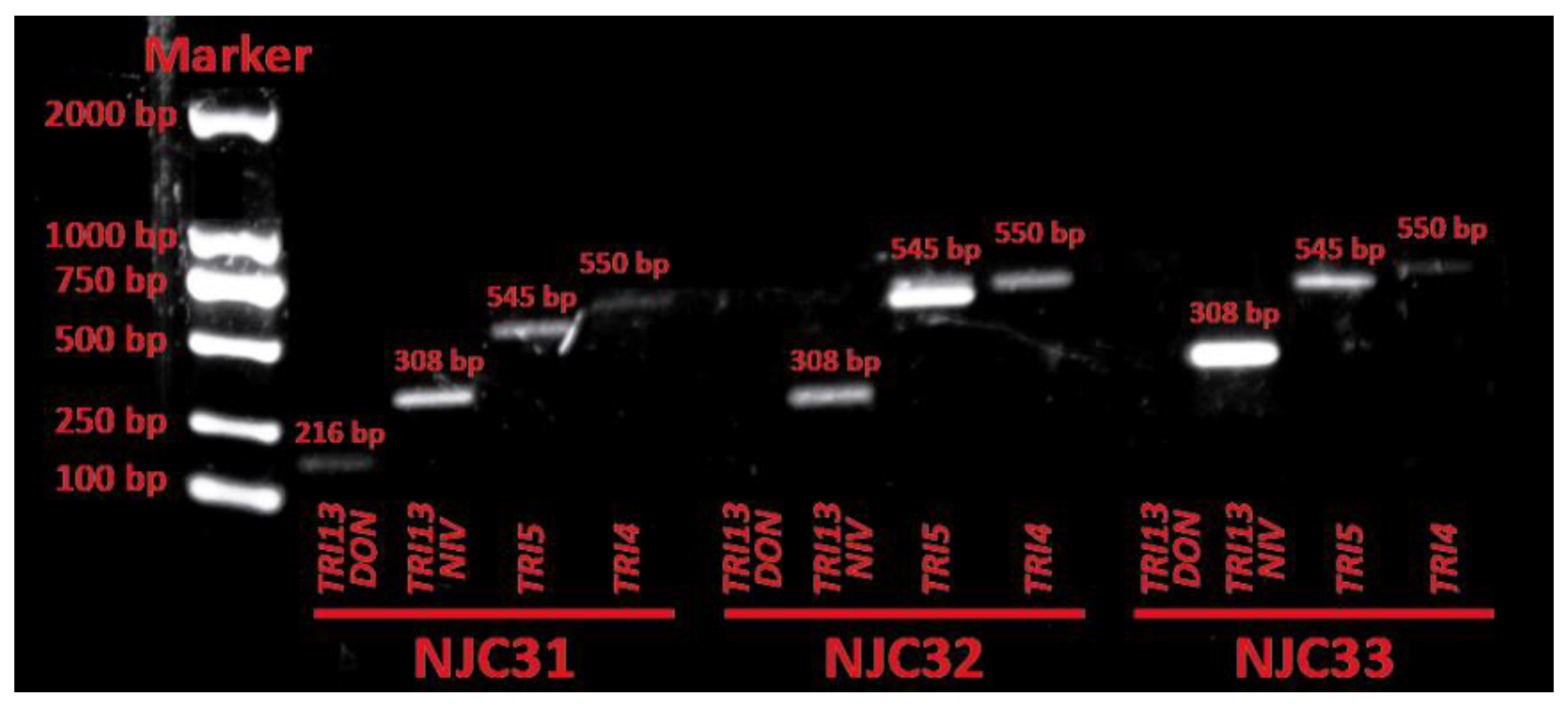
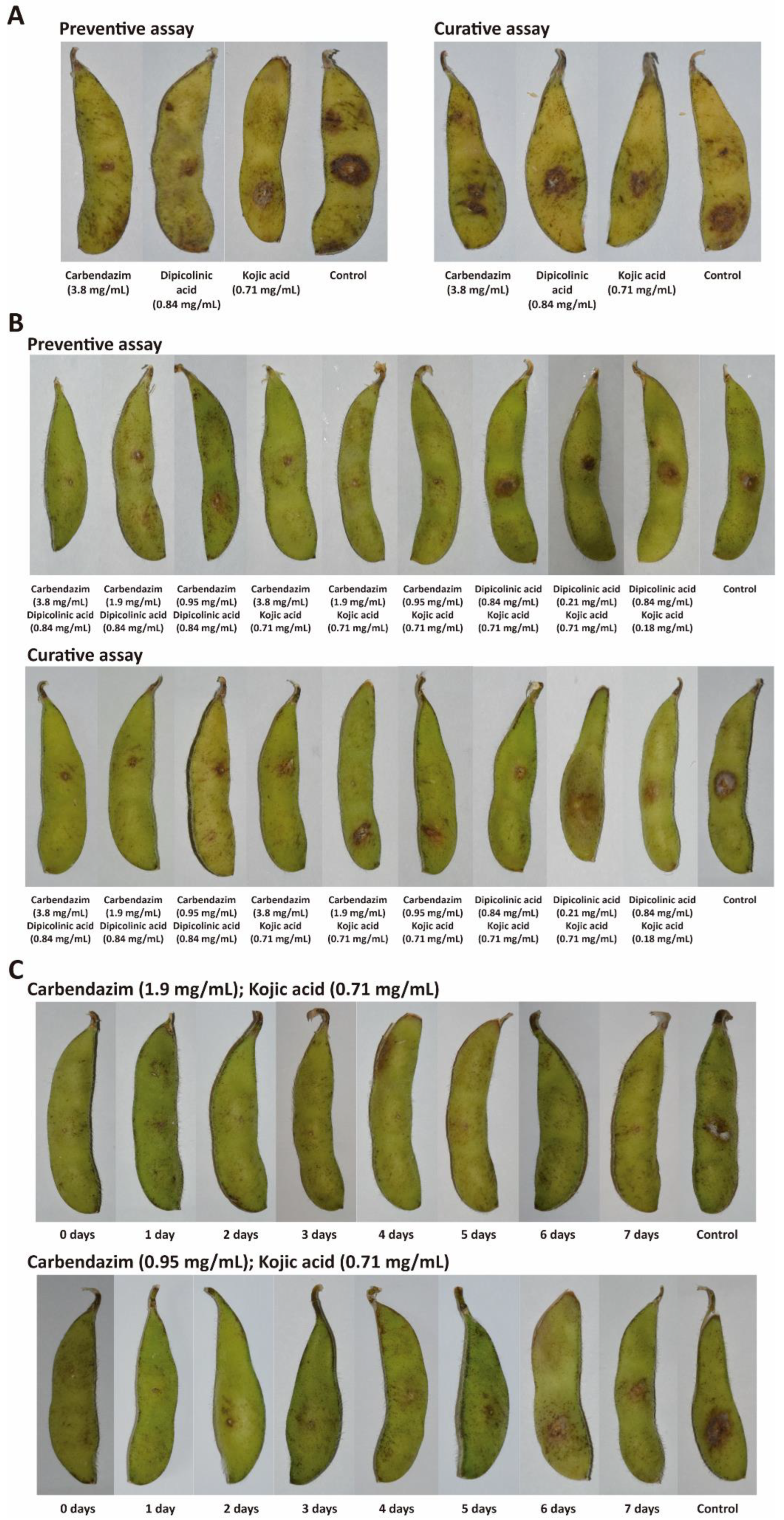
| Application | Antifungal Agent | Concentration (mg/mL) | Lesion Length (mm) 1,2 | Inhibitory Activity (%) |
|---|---|---|---|---|
| Preventive | Carbendazim | 3.80 | 0.95 ± 0.38 b | 76.2 |
| Dipicolinic acid | 0.84 | 2.78 ± 1.20 ab | 33.3 | |
| Kojic acid | 0.71 | 3.02 ± 1.67 ab | 28.6 | |
| Control 3 | - | 4.27 ± 1.93 a | - | |
| Curative | Carbendazim | 3.80 | 4.17 ± 1.93 a | - |
| Dipicolinic acid | 0.84 | 4.77 ± 2.16 a | - | |
| Kojic acid | 0.71 | 4.63 ± 2.25 a | - | |
| Control 3 | - | 4.00 ± 1.91 a | - |
| Application | Antifungal Agent (Concentration; mg/mL) | Lesion Length (mm) 1,2 | Inhibitory Activity (%) |
|---|---|---|---|
| Preventive | Carbendazim (3.8); Dipicolinic acid (0.84) | 0.77 ± 0.49 b | 82.7 |
| Carbendazim (1.9); Dipicolinic acid (0.84) | 1.25 ± 0.60 b | 71.8 | |
| Carbendazim (0.95); Dipicolinic acid (0.84) | 1.30 ± 0.72 b | 70.7 | |
| Carbendazim (3.8); Kojic acid (0.71) | 0.80 ± 0.25 b | 82.0 | |
| Carbendazim (1.9); Kojic acid (0.71) | 0.67 ± 0.48 b | 84.9 | |
| Carbendazim (0.95); Kojic acid (0.71) | 4.17 ± 1.97 a | 6.0 | |
| Dipicolinic acid (0.84); Kojic acid (0.71) | 3.57 ± 1.29 a | 19.5 | |
| Dipicolinic acid (0.21); Kojic acid (0.71) | 4.30 ± 1.74 a | 3.0 | |
| Dipicolinic acid (0.84); Kojic acid (0.18) | 4.11 ± 1.51 a | 7.1 | |
| Control 3 | 4.43 ± 1.52 a | - | |
| Curative | Carbendazim (3.8); Dipicolinic acid (0.84) | 2.41 ± 1.47 a | 49.1 |
| Carbendazim (1.9); Dipicolinic acid (0.84) | 2.62 ± 1.25 a | 44.7 | |
| Carbendazim (0.95); Dipicolinic acid (0.84) | 2.68 ± 1.88 a | 43.3 | |
| Carbendazim (3.8); Kojic acid (0.71) | 3.48 ± 1.62 a | 26.4 | |
| Carbendazim (1.9); Kojic acid (0.71) | 4.83 ± 2.33 a | - | |
| Carbendazim (0.95); Kojic acid (0.71) | 4.40 ± 1.84 a | 7.0 | |
| Dipicolinic acid (0.84); Kojic acid (0.71) | 3.17 ± 1.68 a | 33.1 | |
| Dipicolinic acid (0.21); Kojic acid (0.71) | 4.38 ± 2.49 a | 7.4 | |
| Dipicolinic acid (0.84); Kojic acid (0.18) | 4.57 ± 2.61 a | 3.5 | |
| Control 3 | 4.73 ± 1.44 a | - |
| Antifungal Agent (Concentration; mg/mL) | Time between Application of the Fungicides and Inoculation of the Pathogen (days) | Lesion length (mm) 1,2 | Inhibitory Activity (%) |
|---|---|---|---|
| Carbendazim (1.9 mg/mL); Kojic acid (0.71 mg/mL) | 0 | 0.93 ± 0.70 b | 77.6 |
| 1 | 0.99 ± 0.74 b | 76.2 | |
| 2 | 0.90 ± 0.55 b | 78.4 | |
| 3 | 0.78 ± 0.31 b | 81.3 | |
| 4 | 0.76 ± 0.49 b | 81.7 | |
| 5 | 0.94 ± 0.45 b | 77.5 | |
| 6 | 0.86 ± 0.45 b | 79.4 | |
| 7 | 1.11 ± 0.64 b | 73.3 | |
| Control 3 | 4.16 ± 0.98 a | - | |
| Carbendazim (0.95 mg/mL); Kojic acid (0.71 mg/mL) | 0 | 1.02 ± 0.90 c | 77.5 |
| 1 | 0.73 ± 0.69 c | 83.9 | |
| 2 | 1.77 ± 0.73 bc | 60.9 | |
| 3 | 2.27 ± 0.99 bc | 49.9 | |
| 4 | 2.23 ± 1.19 bc | 50.8 | |
| 5 | 2.52 ± 1.21 abc | 44.4 | |
| 6 | 3.31 ± 1.27 ab | 26.9 | |
| 7 | 3.40 ± 1.37 ab | 24.9 | |
| Control 3 | 4.53 ± 1.12 a | - |
Publisher’s Note: MDPI stays neutral with regard to jurisdictional claims in published maps and institutional affiliations. |
© 2022 by the authors. Licensee MDPI, Basel, Switzerland. This article is an open access article distributed under the terms and conditions of the Creative Commons Attribution (CC BY) license (https://creativecommons.org/licenses/by/4.0/).
Share and Cite
Sun, Q.; Zhang, S.-L.; Xie, Y.-J.; Xu, M.-T.; Herrera-Balandrano, D.D.; Chen, X.; Wang, S.-Y.; Shi, X.-C.; Laborda, P. Identification of New Fusarium sulawense Strains Causing Soybean Pod Blight in China and Their Control Using Carbendazim, Dipicolinic Acid and Kojic Acid. Int. J. Environ. Res. Public Health 2022, 19, 10531. https://doi.org/10.3390/ijerph191710531
Sun Q, Zhang S-L, Xie Y-J, Xu M-T, Herrera-Balandrano DD, Chen X, Wang S-Y, Shi X-C, Laborda P. Identification of New Fusarium sulawense Strains Causing Soybean Pod Blight in China and Their Control Using Carbendazim, Dipicolinic Acid and Kojic Acid. International Journal of Environmental Research and Public Health. 2022; 19(17):10531. https://doi.org/10.3390/ijerph191710531
Chicago/Turabian StyleSun, Qing, Shi-Ling Zhang, Yong-Jing Xie, Mei-Ting Xu, Daniela D. Herrera-Balandrano, Xin Chen, Su-Yan Wang, Xin-Chi Shi, and Pedro Laborda. 2022. "Identification of New Fusarium sulawense Strains Causing Soybean Pod Blight in China and Their Control Using Carbendazim, Dipicolinic Acid and Kojic Acid" International Journal of Environmental Research and Public Health 19, no. 17: 10531. https://doi.org/10.3390/ijerph191710531
APA StyleSun, Q., Zhang, S.-L., Xie, Y.-J., Xu, M.-T., Herrera-Balandrano, D. D., Chen, X., Wang, S.-Y., Shi, X.-C., & Laborda, P. (2022). Identification of New Fusarium sulawense Strains Causing Soybean Pod Blight in China and Their Control Using Carbendazim, Dipicolinic Acid and Kojic Acid. International Journal of Environmental Research and Public Health, 19(17), 10531. https://doi.org/10.3390/ijerph191710531









